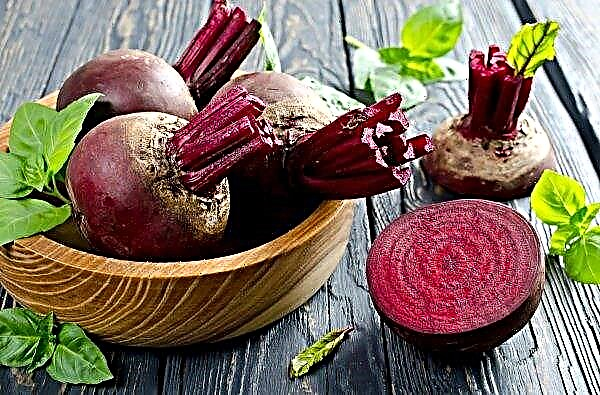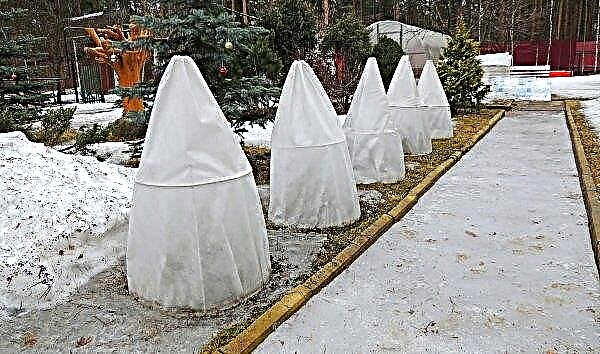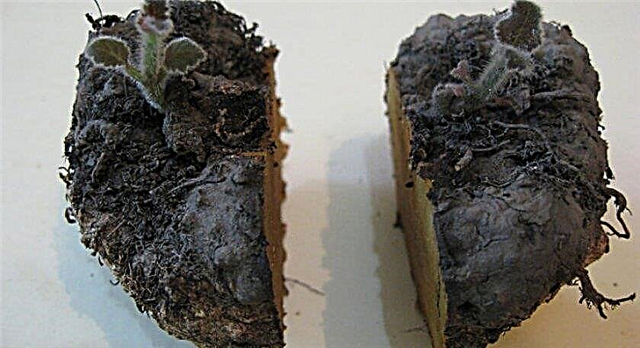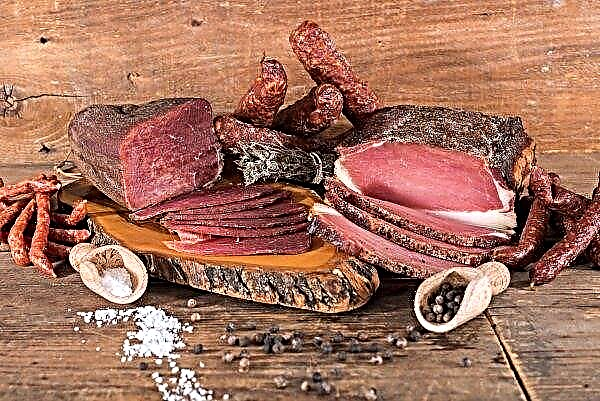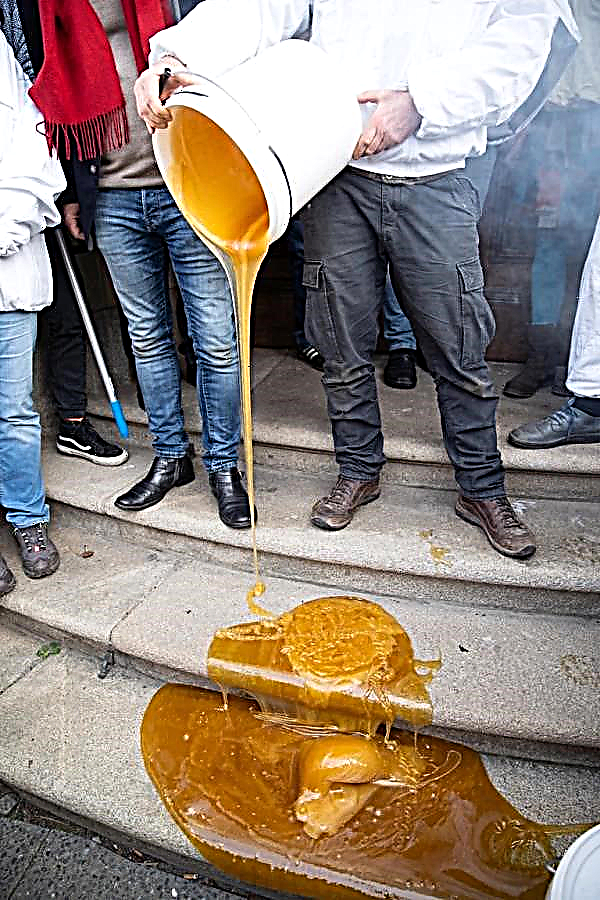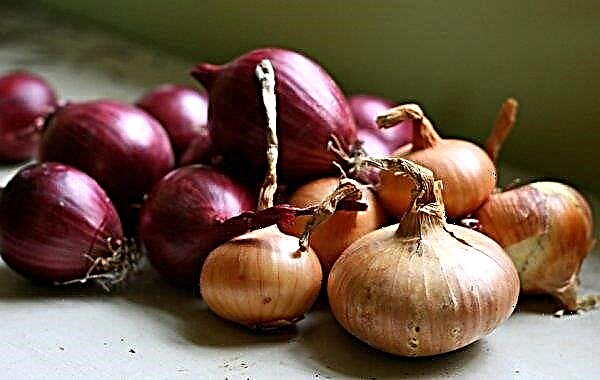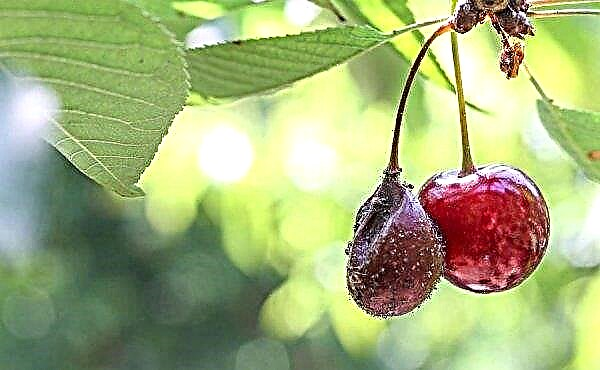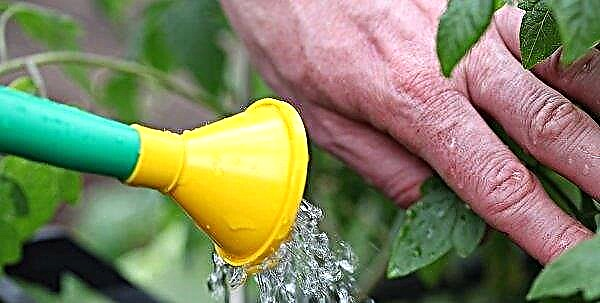Exotic brightly flowering plants occupy a special niche in indoor floriculture. One of the representatives of decorative exotics is reed guzmania. The cultivation and propagation of the flower will be discussed later in the article.
Botanical description of the plant
The plant is an epiphyte, that is, it lives and develops on the bark of trees and shrubs of the tropical rainforest of South America. At home, the bush grows to 45 cm, forming a dense rosette of bright leaves. The leaf plates are wide, up to 4 cm, up to 40 cm long, they are bright green in color, with a glossy skin.
Guzmania begins to bloom in late winter and early spring. The inflorescence appears from the very center of the leaf rosette on a thick peduncle. It is dense, in the shape of an ear, collected from several bright bracts. The flower itself is not as decorative as the bracts, consists of many small petals.
Did you know? Red guzmania can completely compete with the money tree: it brings material wealth to the house. And the plant activates creativity. Only you need to choose the right location.
The flowering period lasts only a few days, but the bracts do not lose color brightness for several months. After the mother plant dies, leaving the lateral processes.
| Root system | Superficial, underdeveloped |
| Stem | Leaf socket |
| Leaf shape | Reed |
| Leaf color | Bright green |
| Inflorescence shape | Spike-like |
| Color of flowers | Red, Burgundy, White, Yellow, Pink |
House growing conditions
Epiphyte is demanding on microclimate conditions. Its development and ability to start will depend on compliance with the conditions of detention.
Location and Lighting
The plant needs a lot of light, but at the same time direct sunlight is destructive to delicate greenery. Southern windows in the period of active sun need to be shaded. On poorly lit northern windowsills, guzmania refuses to bloom and is stunted.
Temperature and humidity
The tropical flower needs warm conditions: the temperature of the content is + 20 ... 25 ° С. In late autumn, the temperature is gradually lowered to + 16 ... 18 ° C, preparing the bush for a rest period.
Important! Drafts are strictly forbidden: the lights will destroy the bright foliage, jeopardize the flowering period.
Tropical plants need high humidity. He is comfortable near aquariums, humidifiers. Daily (preferably morning and evening) the air around the bush is sprayed from the sprayer. Leaves should be regularly cleaned from dust with a damp cloth.
How to care at home
Leaving consists in standard procedures, but there are some important nuances.
Watering
Watering guzmania is one of the most responsible procedures. Epiphyte water should be 3-4 degrees higher than air temperature. The ideal option is rainwater. Tap water needs to be filtered out, since any substances from the line adversely affect the development of the plant.
You can use a home filter: activated carbon, wrapped in several cotton swabs. The filter is pressed against the tap opening and water is passed through it with a fine jet.
Watering is carried out by several methods:
- soil coma irrigation - no more than 2 times a week. In winter, watering is reduced by watering the soil only after the soil dries up to half the volume;
- drip (inside the outlet) - during the period of growth and flowering, the outlet should be 2-3 cm filled with water. Every week the water is changed. In winter, the outlet must be dry;
- lower watering - apply once every 10 days. The container is immersed in water until the soil is completely moistened.
In the outlet, water should always be present, with the exception of winter. Watering the soil — irrigation or lower — is selected at the discretion of the grower.
Fertilizer application
It is better to use a mineral complex (for example, "Success").
A balanced composition nourishes the roots and green mass, enhances resistance to diseases (chlorosis most often). The dosage is reduced three times from the norm indicated on the package. Fertilize during the period of active development - from May to August - with an interval of 2 weeks.
Fertilize during the period of active development - from May to August - with an interval of 2 weeks.
Pruning
Pruning as such is not carried out, because after the flower dries and the inflorescence withers, the plant dies. But in order to prolong his life and longer enjoy the bright bracts, a wilted flower is removed from the top.
Transfer
The transplant is carried out once every 2-3 years, in the spring. Pots are recommended wide and shallow. It is better to prepare the soil for epiphyte yourself.
For the soil mixture take the following components:
- pine bark (chopped) - 3 parts;
- chopped sphagnum - 1 part;
- peat - 1 part;
- humus - 0.5 parts.
Expanded clay is used as a drainage layer, filling it with a third of the volume of the pot.
The sequence of operations during the transplant will be as follows:
- The soil lump is moistened to make it easier to remove the bush along with the roots without damaging them.
- The plant is thrown out of the old container, dried leaves are removed.
- Pour a layer of soil onto the drainage, carefully place the bush on the soil and fill it up on all sides of the pot.
- The root neck is not deepened, it remains on the surface.
- The transplanted bush is removed in the shade for 3-4 days, wetting the soil lump daily.

Breeding
Guzmania is propagated by two methods: by children and by seeds.
Before sowing, the seed material must be decontaminated by soaking for 2-3 hours in a solution of manganese. The soil mixture is also disinfected by steaming in a water bath. Soil is prepared from peat and coarse sand in equal proportions.
In detail about sowing technology:
- Seeds are scattered on the surface of the soil, slightly pressing in, but not sprinkling.
- The container is covered with a film and put on germination in a warm place at a temperature of +24 ° C.
- Ventilate and spray the soil regularly.
- Shoots appear after 2-3 weeks.
- At the age of 2.5 months, seedlings are transplanted into separate containers in the ground for adult specimens.
With growth, guzmania forms several lateral processes. Children are used as planting material for reproduction. A similar method is relevant after an adult bush fades. It is removed from the pot, the “children” with roots are carefully separated with a sharp knife and transplanted into a new container, as well as adult bushes.
Did you know? Blooming guzmania shows the properties of an aphrodisiac, increasing the sexual attraction of partners. That is why the plant is often placed in the bedroom.
Growing difficulties
Some plant diseases are possible due to errors in care, others can be triggered by insects that have fallen on the flowerpot. The main problems of guzmania and methods of dealing with them:
The main problems of guzmania and methods of dealing with them:
- Chlorosis - withering tops, yellowing and twisting of foliage. May be of fungal origin. It is necessary to pay attention to humidity: reduce watering, change the water in the socket in time, and remove it for the winter. Viral chlorosis occurs due to a lack of minerals. Feed on time, in complex formulations (soil mix for orchids is suitable).
- The plant has stopped growing - lack of lighting. Move the flowerpot to an open, illuminated space.
- The appearance of dry brown spots on leaves and stems - sunburn. If the sun is too active, protect the plant with a curtain of lightweight fabric.
- Does not bloom, does not form children - root rot is possible. The bush needs to be removed and inspected the roots, remove damaged areas. You can transplant into a new tank and monitor the rate of irrigation. If the roots are intact, then there is not enough nutrition, feed the plant.
- The appearance of black dots on the foliage signals the defeat of the spider mite. You need to deal with it with the help of acaricide (for example, Apollo). Processing is carried out according to the instructions, if necessary, repeat after 2 weeks.
- Gray-brown plaques on the foliage indicate the presence of scale insects. With a small number of insects, it is enough to treat with soapy water and rinse the leaves. In the advanced case, it is better to resort to insecticidal treatment with Actellik.
- Cotton balls on the bush indicate an attack by the mealybug. Insecticides "Aktara", "Aktellik" will help get rid of the insect.
Important! Organics contain a large amount of nitrogen, which is detrimental to bromeliad plants (guzmania is also a representative of this family).
Guzmania reed is appreciated by flower growers for the decorative qualities of the bush and inflorescences. A bright flower brings positive energy to the house, uplifting. The main thing is to follow all the recommendations for caring for him.

